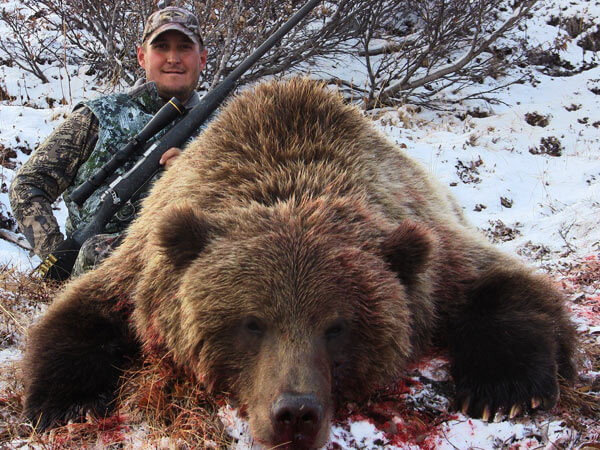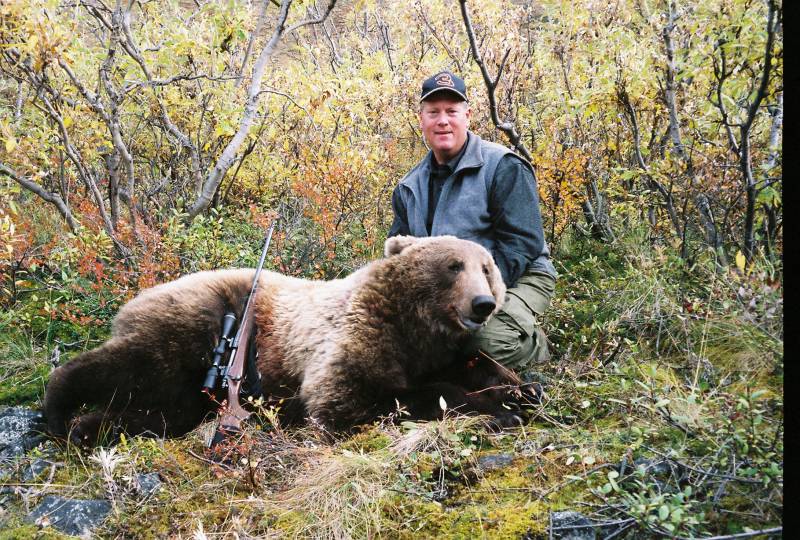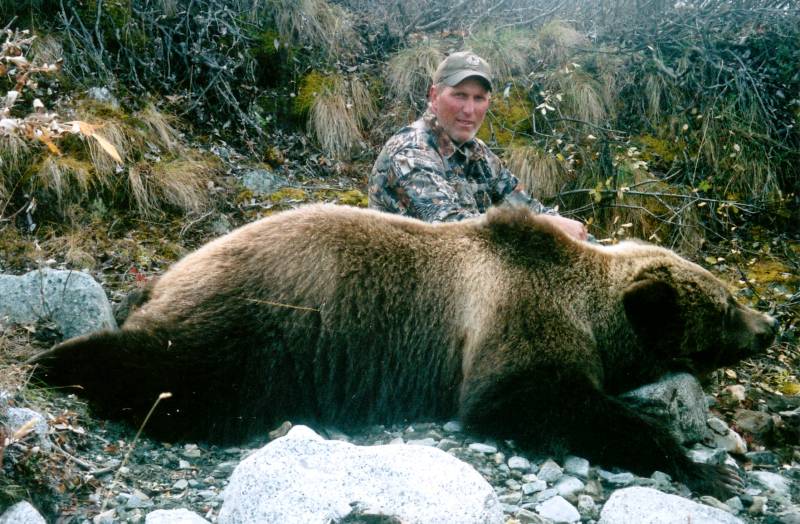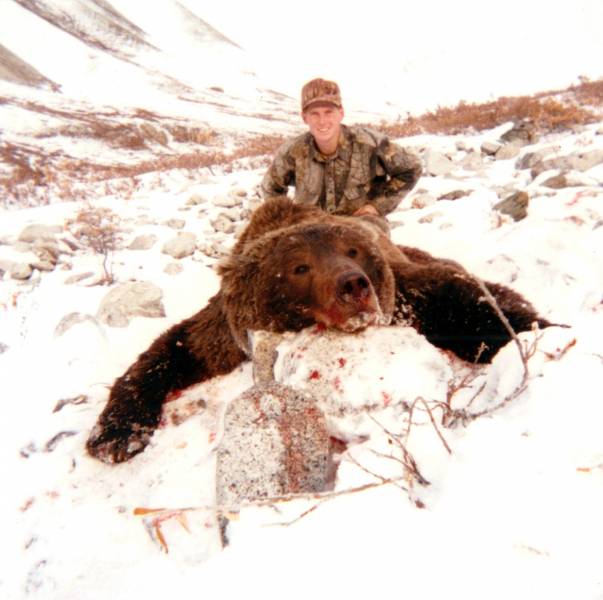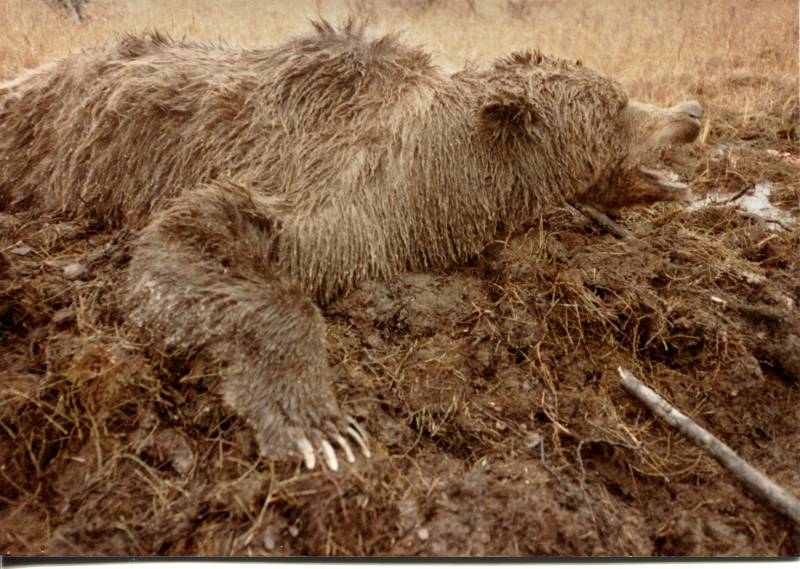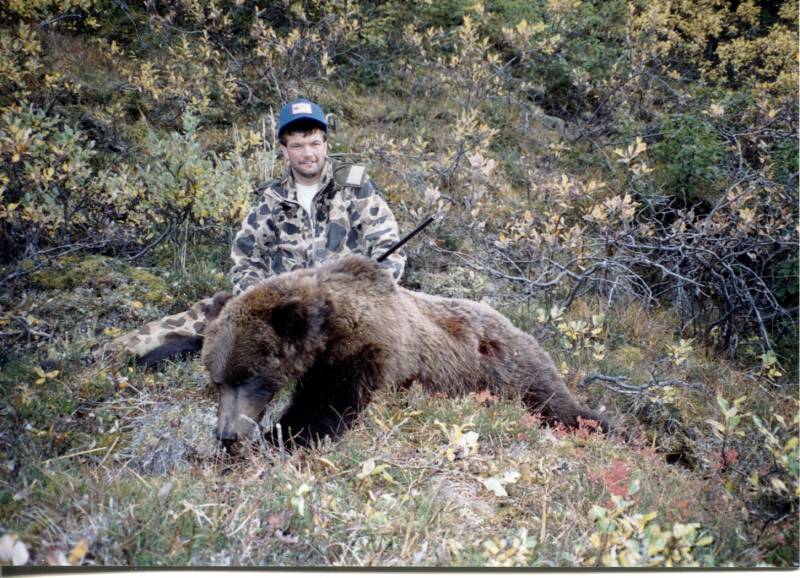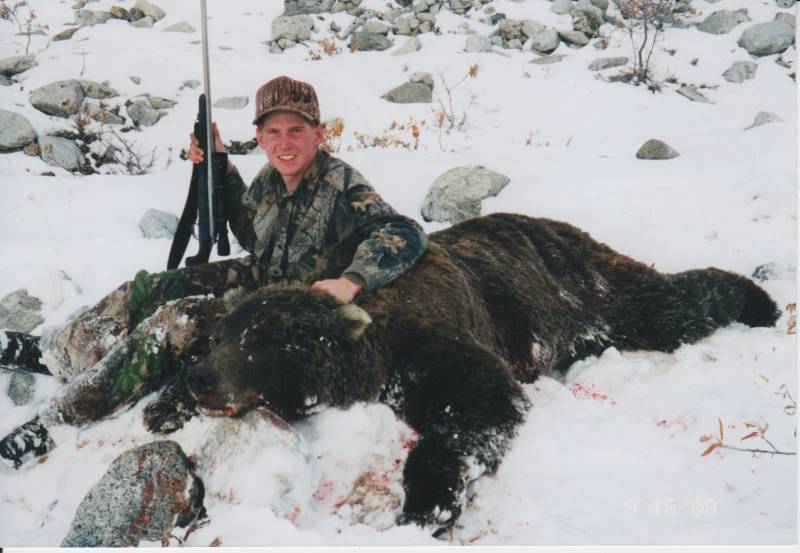Grizzly bear hunting in Alaska offers a captivating and rewarding experience for hunters at any level of experience. This challenging activity is more than a pursuit; it’s an opportunity to engage with the wilderness and gain a deeper appreciation for the untamed landscapes of Alaska. With a significant number of grizzlies throughout the state, hunters have plenty of chances to encounter and potentially harvest these formidable animals.
Our Grizzly bear hunts unfold in the scenic Alaska Range, just south of Fairbanks. This region, with its dense willow thickets and expansive meadows, is considered one of the premier habitats for grizzly bear hunting in the state.
Hunters have the option to track grizzly bears exclusively or to participate in a combination hunt that also targets moose. The abundant populations of both species in this area mean excellent prospects for securing trophy-sized specimens. The territory is known for yielding impressive grizzlies, some reaching up to 9 feet square, and moose with antler spreads of 60 inches.
The hunting experience is further enhanced by the stunning autumn colors that sweep across the landscape. Our base camps provide comfort in the heart of the wilderness, varying from cozy cabins to sturdy Cabela’s dome tents, each with a separate cook tent for preparing meals.
Prices
Interior Grizzly
10-Day Hunt: $21,000
14-Day Hunt: $25,000
Grizzly and Dall Sheep Combo
10-Day Hunt: $37,000
14-Day Hunt: $39,500
Grizzly and Moose Combo
10-Day Hunt: $36,000
14-Day Hunt: $39,000
Other Hunts
Grizzly Bear Hunting: Essential Tips and Techniques
Grizzly bear hunting has always been a topic of great interest for hunters and wildlife enthusiasts alike. With recent debates surrounding the ethics of hunting as well as concerns over the preservation of grizzly bear populations, it’s important to examine the facts and understand the current regulations in place.
Grizzly bears, a subspecies of the North American brown bear, are sought after for the challenge they pose, as well as their impressive size and undeniable majesty.
In all areas of Alaska, grizzly bear hunting is carefully managed and regulated to ensure the survival of the species while also allowing hunters the opportunity to pursue these formidable creatures.
Through understanding the practice of grizzly bear hunting, as well as the regulations and conservation efforts in place, readers can form a better grasp of this enduring and emotive subject.
Grizzly Bear Hunting Basics
Grizzly vs. Black Bears
When planning a grizzly bear hunting trip, it’s essential to understand the differences between grizzly bears and black bears. Grizzlies tend to be larger, with a hump over their shoulders and a concave face. Their fur color can vary from light blonde to dark brown.
On the other hand, black bears have no shoulder hump, and their face is straighter. They can be black, brown, or even cinnamon-colored. It’s crucial to identify the species correctly, as hunting regulations and tactics may differ between them.
Understanding Grizzly Behavior
Grizzly bears are solitary animals that roam large territories searching for food. They primarily feed on berries, plants, and fish. However, during the fall months, they actively seek calorie-dense foods such as moose to prepare for hibernation.
Grizzlies are known for their fierce temperament and unpredictable nature, so hunters must take extra precautions to ensure their safety.
When hunting grizzlies, it’s essential to be aware of their behaviors and natural habitats. Grizzlies are commonly found near rivers and streams, especially during the salmon spawning season. It’s also crucial to be cautious around carcass sites, as these bears may return to a kill to defend their food.
Hunters should use their knowledge of grizzly behavior to locate and approach them. Remember to:
- Stay downwind to minimize the chance of bears detecting your scent
- Make noise when in thick cover to avoid surprising a bear
- Use natural terrain features, such as ridges or creeks, to remain unseen
Understanding the differences between grizzly and black bears, as well as knowing their behavior and habitat preferences, is key to a safe and successful hunting experience. Hunters should always exercise caution and follow local regulations when pursuing these formidable animals.
Hunting Locations and Seasons
North America Range
Grizzly bears are found in various regions across North America, such as Alaska, the Yukon Territory, and the Greater Yellowstone Ecosystem. Their range extends from Alaska down to Montana, providing ample opportunities for hunting these majestic creatures.
Alaska and Yukon
In Alaska, grizzly bear hunting seasons usually occur in spring and fall, providing different opportunities depending on the region. On Kodiak Island, the fall season occurs in September and October, while spring hunts usually range from April to May.
Grizzlies inhabit inland, northern, and Arctic areas of Alaska, and hunting is available in several regions, including the Kodiak/Afognak Archipelago and other parts of the state.
In both Alaska and Yukon, hunters can target grizzlies as they pursue their natural prey, such as caribou, elk, and moose.
Montana and Greater Yellowstone Ecosystem
The Greater Yellowstone Ecosystem, which includes parts of Montana, has a limited and carefully managed hunting season for grizzly bears. The U.S. Fish and Wildlife Service oversees the conservation efforts in this region, ensuring that hunting quotas are maintained to protect the grizzly bear population.
Altogether, grizzly bear hunting seasons and locations can vary across North America, so it is crucial for hunters to research specific regions, obtain proper permits, and adhere to guidelines provided by local wildlife agencies. Their iconic presence in the region makes grizzly bears a challenging yet rewarding target for seasoned hunters.
Hunting Methods and Equipment
Spot and Stalk
Spot and stalk is a popular hunting method for grizzly bears. Hunters, often accompanied by an outfitter or guide, venture into the wilderness where grizzlies are known to inhabit. They observe the area from a safe distance, looking for signs of the bears, such as tracks, scat, and disturbed vegetation.
Once a grizzly is spotted, the hunters carefully approach it, making use of natural cover and wind direction to remain undetected. This method requires patience, stealth, and a keen understanding of wildlife behavior.
Combination Hunts
Combination hunts are another option, particularly if hunters are targeting multiple game species like moose or wolf alongside grizzlies. In these hunts, hunters typically pursue different game species in a single trip.
This method requires good planning and adaptability and offers increased opportunities for success by maximizing time spent in the wilderness.
Rifle
Rifles are the most common choice for grizzly hunting. A rifle with a powerful caliber, such as a .338 Winchester Magnum or a .375 Ruger, can ensure sufficient stopping power in a single shot. The rifle must have a good range, allowing for accurate shots at distances of 200 yards or more.
Rifles should be combined with quality optics for better visibility in Alaska’s often challenging weather conditions.
Bow
Bow hunting grizzlies is an increasingly popular pursuit, but it requires a higher level of skill and experience compared to rifle hunting. Heavier draw-weight bows are essential, as grizzlies have thick hides and dense muscle tissue.
Choosing broadheads with good penetration capabilities, such as fixed blade or mechanical models, can improve the chances of success.
Bow hunters must also be comfortable getting closer to the bears, as the effective range for a bow is usually within 50 yards, which adds an element of risk and excitement.
Pistol
Pistol hunting for Alaskan grizzlies is less common than rifle or bow hunting, but some experienced hunters prefer this method for its increased challenge. A large caliber handgun, such as a .44 Magnum or a .454 Casull, is necessary to deliver enough stopping power to take down a grizzly.
Pistols offer the advantage of being lightweight and easy to carry but require a high level of marksmanship and comfort with close-range encounters. It is important to note that not all areas permit pistol hunting for grizzlies, so it’s best to check local regulations before embarking on a pistol-based hunt.
Preparing for a Grizzly Bear Hunt
Selecting an Outfitter
When planning a grizzly bear hunt, it’s essential to choose a reputable outfitter. They should have extensive experience and a good success rate in guiding grizzly hunts. Look for testimonials and reviews from previous clients, and be sure to contact the outfitter with any questions or concerns about their services. You may also need to enlist a licensed outfitter if you’re a non-resident hunter in certain regions.
Hunt Prices and Trophy Fees
Grizzly bear hunts can be quite expensive, with prices typically ranging from $10,000 to $25,000 or higher. In addition to the outfitter’s fee, you should also consider the cost of licenses, tags, and airline transportation. Be prepared to pay a trophy fee upon harvesting a bear, which can vary depending on the region and size of the bear. Keep in mind that grizzly hunting is a limited season, so booking early is recommended.
Gear List
To ensure a successful hunt, be well-equipped with the appropriate gear. Some essential items to include on your grizzly hunting gear list are:
- A suitable firearm or bow with adequate stopping power for grizzlies
- Ammunition or arrows/broadheads designed for big game hunting
- Hunting clothes, including quality base layers, rain gear, and insulation for potentially harsh weather conditions
- Quality backpack or pack system to carry gear and potentially bear meat
- Optics, such as binoculars or a spotting scope for locating bears at long distances
- Personal survival gear, including a first aid kit, knife, rope, firestarter, and navigation tools
Remember that you may be covering 15 miles a day walking and glassing, so choose lightweight, durable equipment to minimize fatigue.
Planning
Once you have chosen an outfitter and compiled your gear list, it’s time to prepare yourself for the physical and mental demands of a grizzly bear hunt. Training for the hunt should include conditioning to handle long walks and uneven terrain, as well as practice shooting in various scenarios to improve accuracy and confidence. Additionally, educate yourself on grizzly bear behavior and habitat to increase your chances of a successful encounter.
By taking the time to properly prepare and plan for your grizzly bear hunt, you can increase your chances of success and make the most out of your adventure in the wilderness.
Grizzly Bear Conservation and Safety
Cubs and Denning Behavior
Grizzly bears are known to give birth to their cubs in dens during winter. This denning behavior typically occurs in mountainous regions where the bear can find suitable sites for their dens.
Cubs are born blind, hairless, and completely dependent on their mother for warmth, protection, and nourishment. Mother grizzlies are known to be extremely protective of their young, making it crucial for hunters and outdoor enthusiasts to maintain a safe distance from any denning sites they may encounter.
Research Purposes and Demographic Monitoring
To ensure a healthy grizzly bear population, it’s essential to conduct ongoing research and demographic monitoring. This can include tracking individual bears using GPS collars, estimating population size through spot and stalk techniques, and monitoring specific combination factors such as reproduction rates and habitat conditions. This information helps wildlife managers make informed decisions about bear conservation efforts, including hunting regulations and population management strategies.
Minimizing Conflict with People
As human populations expand and encroach upon grizzly bear habitat, it’s becoming increasingly important to minimize conflict with people. Some measures that can be taken to reduce the likelihood of negative encounters include:
- Educating the public on bear safety, including proper food storage and disposal in bear country
- Implementing bear-resistant products to deter bears from accessing human food and garbage
By taking these steps, both grizzly bears and humans can safely coexist, ensuring the continued survival and conservation of this magnificent species.
Frequently Asked Questions
What is the best location for grizzly bear hunting?
Grizzly bear hunting is most popular in Alaska, where the population is dense, and the hunting opportunities are plentiful. [source(https://www.wideopenspaces.com/grizzly-bear-hunting/).
What is the difference between grizzly and brown bear hunting?
Grizzly and brown bears are the same species, but the term “grizzly” typically refers to bears in inland areas, while “brown bear” is used for coastal populations. Their hunting behavior and habitats can differ, but the tactics and techniques used to hunt them are generally similar.
How can one prepare for a successful grizzly bear hunt?
Preparation is key when it comes to grizzly bear hunts. Hunters should invest in good quality gear, appropriate clothing for weather conditions, and proper firearms. Knowledge of the area and local regulations is also crucial. Additionally, taking precautions to stay safe in grizzly country is important, such as having bear spray and knowing how to handle possible encounters source.
What’s the average cost of a guided grizzly bear hunt in Alaska?
The cost of a guided grizzly bear hunt in Alaska can vary greatly depending on the outfitter and the duration. On average, expect to pay between $10,000 and $20,000 for a fully guided hunt in Alaska. This usually includes accommodations, meals, transportation, and the services of a professional guide.
What are the legal requirements for hunting grizzly bears?
Grizzly bears are a protected species in some areas, and hunting regulations vary depending on the location. Generally, a hunting license and a big game tag are required to hunt grizzly bears, and hunters must follow bag limits and specific hunting seasons. It is crucial to research the regulations in the area you plan to hunt before embarking on a grizzly bear hunt source.
What is the hunting season for grizzly bears in North America?
The hunting season for grizzly bears varies depending on the location but typically runs from spring to late fall. In Alaska, the spring season may start as early as April, while the fall season generally begins in September and can extend into November. In some parts of the Yukon, there may be a late-season hunt in December. It is essential to check the hunting season dates for the specific area you plan to hunt.
